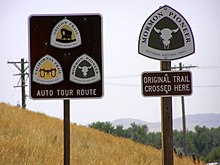
Back Národní turistické stezky (Spojené státy americké) Czech National Trails System German Sistema nacional de senderos de los Estados Unidos Spanish National Trails System French National Trails System Italian Narodowy System Szlaków Polish Система национальных троп США Russian 美国国家步道系统 Chinese


The National Trails System is a series of trails in the United States designated "to promote the preservation of, public access to, travel within, and enjoyment and appreciation of the open-air, outdoor areas and historic resources of the Nation".[2] There are four types of trails: the national scenic trails, national historic trails, national recreation trails, and connecting or side trails. The national trails provide opportunities for hiking and historic education, as well as horseback riding, biking, camping, scenic driving, water sports, and other activities. The National Trails System consists of 11 national scenic trails, 21 national historic trails, over 1,300 national recreation trails, and seven connecting and side trails, as well as one national geologic trail, with a total length of more than 91,000 mi (150,000 km). The scenic and historic trails are in every state, and Virginia and Wyoming have the most running through them, with six.
In response to a call by President Lyndon B. Johnson to have a cooperative program to build public trails for "the forgotten outdoorsmen of today" in both urban and backcountry areas, the Bureau of Outdoor Recreation released a report in 1966 entitled Trails for America.[3] The study made recommendations for a network of national scenic trails, park and forest trails, and metropolitan area trails to provide recreational opportunities, with evaluations of several possible trails, both scenic and historic.[3][4] The program for long-distance natural trails was created on October 2, 1968, by the National Trails System Act, which also designated two national scenic trails, the Appalachian Trail and the Pacific Crest Trail, and requested that an additional fourteen trail routes be studied for possible inclusion.[2] Sponsored by Senators Henry M. Jackson and Gaylord Nelson and Representative Roy A. Taylor,[5] part of the bill's impetus was threats of development along the Appalachian Trail, which was at risk of losing its wilderness character,[4] and the Land and Water Conservation Fund was used to acquire lands.[5] In 1978, as a result of the study of trails that were most significant for their historic associations, national historic trails were created as a new category with four trails designated that year. Since 1968, over forty trail routes have been studied for inclusion in the system.[6]
The scenic and historic trails are congressionally established long-distance trails, administered by the National Park Service (NPS), United States Forest Service (USFS), and/or Bureau of Land Management (BLM). These agencies may acquire lands to protect key rights of way, sites, resources and viewsheds, though the trails do not have fixed boundaries.[4][5] They work in cooperation with each other, states, local governments, land trusts, and private landowners to coordinate and protect lands and structures along these trails, enabling them to be accessible to the public.[7] These partnerships between the agency administrators and local site managers are vital for resource protection and the visitor experience.[5] The Federal Interagency Council on the National Trails System promotes collaboration and standardization in trail development and protection.[7][8] National recreation trails and connecting and side trails do not require congressional action, but are recognized by actions of the secretary of the interior or the secretary of agriculture. The national trails are supported by volunteers at private non-profit organizations that work with the federal agencies under the Partnership for the National Trails System and other trail type-specific advocacy groups.[7][4]
For fiscal year 2021, the 24 trails administered by the NPS received a budget of $15.4 million.[9]
- ^ "The National Historic Trail Logos - National Trails Office - Regions 6, 7, 8 (U.S. National Park Service)". National Park Service. Retrieved April 23, 2021.
- ^ a b 16 U.S.C. § 1241
- ^ a b "Trails for America" (PDF). Department of the Interior – Bureau of Outdoor Recreation. December 1966.
- ^ a b c d "The National Trails System". About.com. June 6, 1999. Archived from the original on November 10, 2000. Retrieved April 11, 2021.
- ^ a b c d Cite error: The named reference
:7was invoked but never defined (see the help page). - ^ 16 U.S.C. §§ 1241–1251
- ^ a b c "The National Trails System Memorandum of Understanding" (PDF). National Park Service. 2016.
- ^ "2017 Federal Agency Highlights for the National Trails System". Partnership for the National Trails System. January 31, 2018. Retrieved May 12, 2021.
- ^ "BUDGET JUSTIFICATIONS and Performance Information Fiscal Year 2022: National Park Service" (PDF). National Park Service. 2021. p. 61.
© MMXXIII Rich X Search. We shall prevail. All rights reserved. Rich X Search